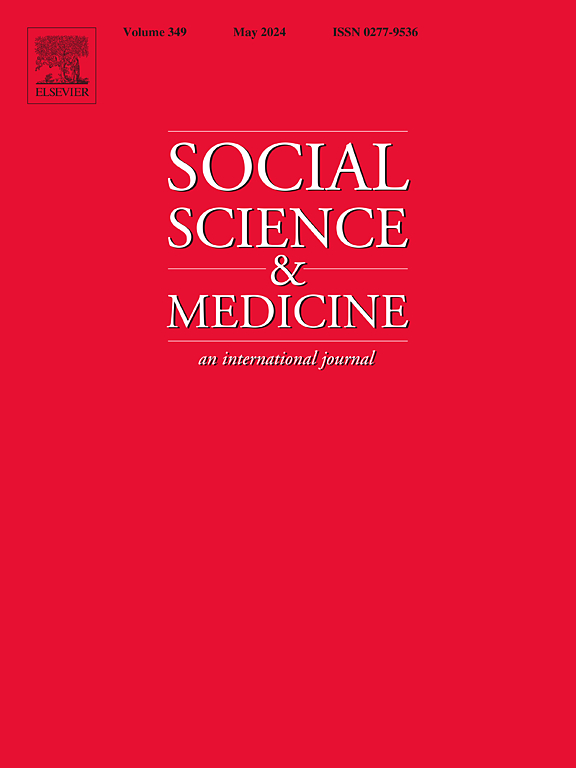Hierarchy, class, race and PPE in an American hospital in the early days of COVID-19: What the pandemic stress test can teach us about building equitable health systems
IF 4.9
2区 医学
Q1 PUBLIC, ENVIRONMENTAL & OCCUPATIONAL HEALTH
引用次数: 0
Abstract
Because hospitals are spaces where life and death are routinely at stake, social hierarchies, pressures, and cultural norms are heightened. This was particularly true in the early days of the COVID-19 pandemic. Examining the dynamics in that era can provide insight into the nature of race and hierarchy in hospital structures.
In the large literature on the experiences of hospital staff in the COVID-19 era, class and racial dynamics in hospitals are often sidestepped. In addition, the experiences of service staff such as environmental service workers and food service workers are severely under-represented.
Here, we explore hierarchy, class, race and risk in two hospitals in the city of Baltimore in the first months of the pandemic in 2020, through the lens of availability of PPE. We draw on a survey of 403 staff in two Baltimore hospitals, and semi-structured interviews with 57 of those staff. Respondents worked in a variety of roles, from administration to clinical to service staff.
A large majority of non-clinical service staff identified as Black, in contrast to a small minority of clinical staff with advanced degrees. The experience of access to PPE in the early pandemic differed across cadres of workers. Everyone in the hospital had to ration PPE, but many service staff felt that they were not prioritized in the same ways as clinical staff. PPE availability took on powerful symbolic resonance as a demonstration of how different cadres of workers were valued.
The COVID-19 pandemic threw social and class dynamics within the hospital into relief, shedding light on what so often ran below the surface. Thus, it could also potentially be an impetus to examine these fault lines, and to push hospital structures a bit more in the direction of justice.
COVID-19 初期美国医院中的等级制度、阶级、种族和个人防护设备:大流行病压力测试对建立公平医疗体系的启示。
由于医院是生死攸关的地方,社会等级、压力和文化规范都会随之加强。这在 COVID-19 大流行的早期尤为明显。研究那个时代的动态可以让我们深入了解医院结构中种族和等级制度的本质。在有关 COVID-19 年代医院员工经历的大量文献中,医院中的阶级和种族动态往往被回避。此外,环境服务人员和餐饮服务人员等服务人员的经历也严重缺乏代表性。在此,我们通过个人防护设备的可用性这一视角,探讨了 2020 年流感大流行最初几个月巴尔的摩市两家医院中的等级制度、阶级、种族和风险。我们对巴尔的摩两家医院的 403 名员工进行了调查,并对其中 57 名员工进行了半结构化访谈。受访者的工作岗位多种多样,有行政人员、临床人员和服务人员。绝大多数非临床服务人员自称是黑人,与之形成鲜明对比的是少数拥有高等学历的临床人员。在大流行初期,不同级别的工作人员获得个人防护设备的情况各不相同。医院里的每个人都必须配给个人防护设备,但许多服务人员认为他们没有像临床人员那样被优先考虑。个人防护设备的可用性具有强大的象征意义,表明了不同级别的工作人员是如何受到重视的。COVID-19 大流行使医院内部的社会和阶级动态变得更加清晰,揭示了经常隐藏在表面之下的问题。因此,它也有可能成为审视这些断层线的动力,并推动医院结构朝着公正的方向发展。
本文章由计算机程序翻译,如有差异,请以英文原文为准。
求助全文
约1分钟内获得全文
求助全文
来源期刊

Social Science & Medicine
PUBLIC, ENVIRONMENTAL & OCCUPATIONAL HEALTH-
CiteScore
9.10
自引率
5.60%
发文量
762
审稿时长
38 days
期刊介绍:
Social Science & Medicine provides an international and interdisciplinary forum for the dissemination of social science research on health. We publish original research articles (both empirical and theoretical), reviews, position papers and commentaries on health issues, to inform current research, policy and practice in all areas of common interest to social scientists, health practitioners, and policy makers. The journal publishes material relevant to any aspect of health from a wide range of social science disciplines (anthropology, economics, epidemiology, geography, policy, psychology, and sociology), and material relevant to the social sciences from any of the professions concerned with physical and mental health, health care, clinical practice, and health policy and organization. We encourage material which is of general interest to an international readership.
 求助内容:
求助内容: 应助结果提醒方式:
应助结果提醒方式:


